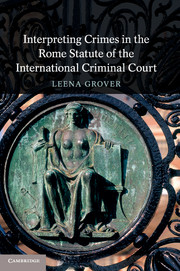Book contents
- Frontmatter
- Dedication
- Contents
- Foreword
- Acknowledgements
- 1 Introduction
- 2 The state of the art
- 3 Guiding interpretive principle
- 4 Challenges to the principle of legality
- 5 Operationalizing the principle of legality
- 6 Custom as an aid to interpretation
- 7 Internal indicia of codification
- 8 External indicia of codification
- 9 The Vienna Convention (1969) and aids to interpretation
- 10 Conclusions
- Bibliography
- Index
- References
5 - Operationalizing the principle of legality
Published online by Cambridge University Press: 05 November 2014
- Frontmatter
- Dedication
- Contents
- Foreword
- Acknowledgements
- 1 Introduction
- 2 The state of the art
- 3 Guiding interpretive principle
- 4 Challenges to the principle of legality
- 5 Operationalizing the principle of legality
- 6 Custom as an aid to interpretation
- 7 Internal indicia of codification
- 8 External indicia of codification
- 9 The Vienna Convention (1969) and aids to interpretation
- 10 Conclusions
- Bibliography
- Index
- References
Summary
Introduction
In this Chapter, consideration will be given to the different elements of article 22 with a view to assessing their origins, purpose and limits. The references to ‘strict interpretation’, ‘favouring the accused’ and the ‘prohibition against analogy’ will be unpacked. In the final section, a method for the principled operationalization of these devices will be outlined to assist judges and lawyers with the interpretation of crimes in the Rome Statute. By giving meaningful content to these imperatives, the goal is to facilitate reasoning by judges and counsel that is informed, principled and transparent. In the absence of this effort, article 22 may be invoked in a manner that leads to interpretive reasoning and outcomes that are over- or underinclusive in some way.
Drafting history
Article 22 provides:
A person shall not be criminally responsible under this Statute unless the conduct in question constitutes, at the time it takes place, a crime within the jurisdiction of the Court.
The definition of a crime shall be strictly construed and shall not be extended by analogy. In case of ambiguity, the definition shall be interpreted in favour of the person being investigated, prosecuted or convicted.
This article shall not affect the characterization of any conduct as criminal under international law independently of this Statute.
At the Rome Diplomatic Conference, the legality principle as it appears in article 22 sparked little debate and was adopted with minor changes. In the International Law Commission’s 1994 and 1996 Draft Statutes of the Court (ILC), the principle of legality was defined so as to accommodate the inclusion of crimes under customary international law – the ‘core crimes’ of aggression, genocide, other crimes against humanity and war crimes – but also treaty crimes, the latter category ultimately not making it into the final Rome Statute. For these ‘core crimes’, the draft language was limited to a prohibition against retroactive application of international law. Thus, so long as the conduct was criminal under international law at the relevant time, it mattered not that national law applicable to the accused did not criminalize the same conduct.
- Type
- Chapter
- Information
- Publisher: Cambridge University PressPrint publication year: 2014



